Most deer may look the same to the untrained eye, but whitetail and mule deer have some striking differences. Though they share a lot of similarities, you can notice plenty of minute differences in their appearance, their behavior, and the geographic locations they occupy. So here I will dive into everything different between these two species so that you can quickly identify them and become a better hunter.
Appearance
While they both look similar, there are certain aspects of their appearance that will be easy to pick out once you know what you are looking for. One of the telltale differences between the two is their tail… see what I did there? Another indication is their coat. Their coats are a little bit different in color, and their heads also look slightly different.
Challenge coins can be used as your own reward after a hunt.
Coat Colors
Coat color is not a signal you can always use right away. Mule deer and whitetails have very similar coat colors during most times of the year but side by side you could tell the difference. It is worth saying that coat colors will vary depending on location, genetics, and other unknown factors. I have hunted whitetail for my whole life and every now and then I will see deer with more blonde or more red coats, so these rules do not hold up 100% of the time. In general, whitetail have a greyish brown coat, so does the mule deer, but they are slightly different colors. The whitetail deer has more of a reddish hue to its coat.
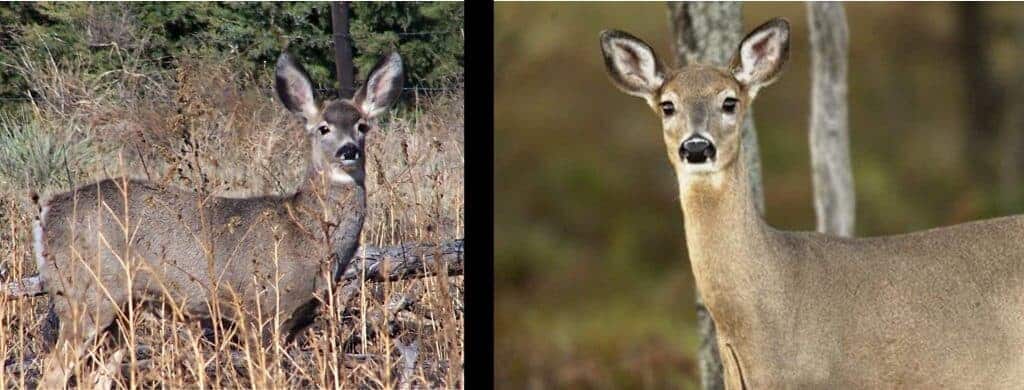
And during the summer whitetail shed their fall coats in favor of a lighter, even redder, summer coat. This color is notably different from mule deer.
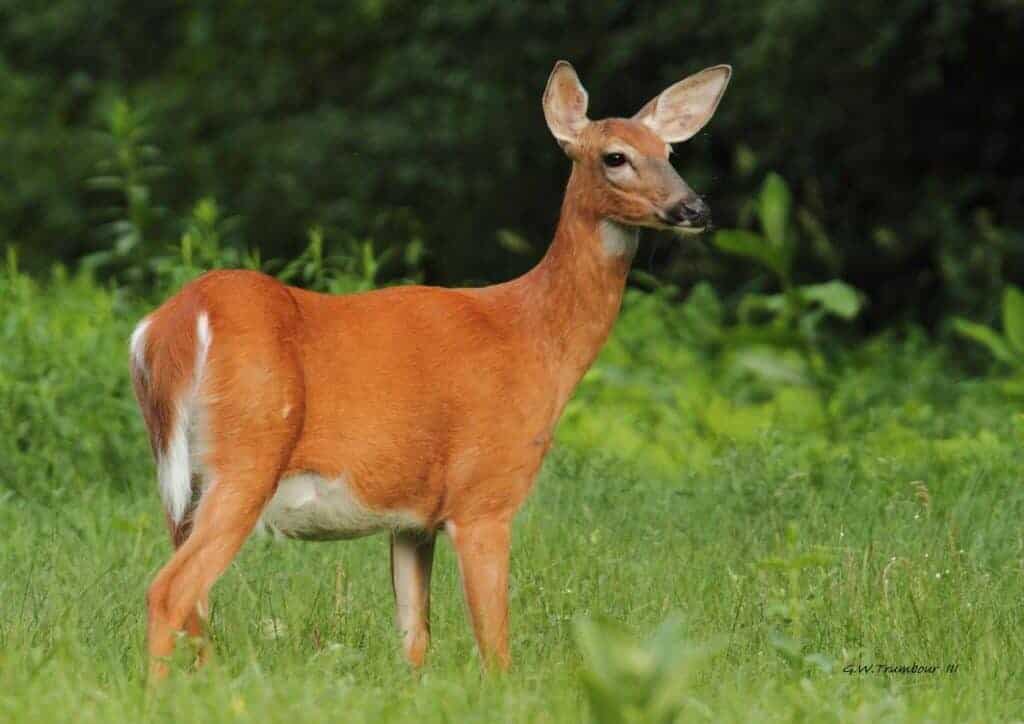
The Head
The head of a mule deer and whitetail are very different when you look at them in detail. The coloration on the face is notably different, as well as the ears. Mule deer and whitetail deer also grow their antlers differently. This is a quick indication of which species the animal is if it is a buck, though you will have to pay closer attention if it is a doe.
The Face
Starting with the first thing you may see, the face of a mule deer looks different from the face of a whitetail. Mule deer have a white patch on their face that goes all the way down to its nose and down the neck. Mule deer also have a dark forehead. Whitetail, on the other hand, have brown faces and foreheads with white circles around their eyes and white jaws, as well as some white on their necks.
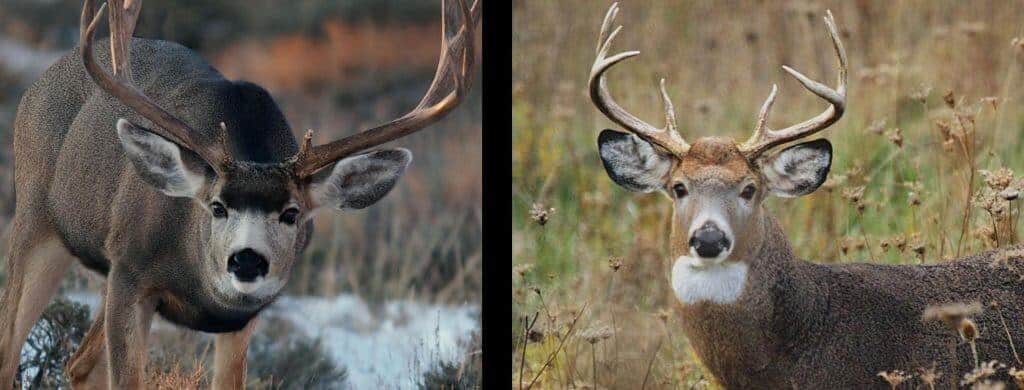
Although if you are looking at mule deer doe, their faces look different than the bucks. Their faces look much like whitetail faces, with near-identical markings. Except the mule deer doe has a lighter face.
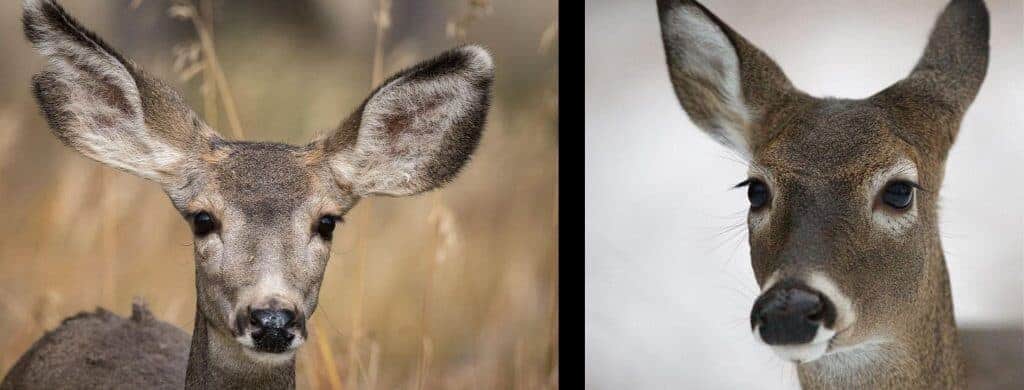
The Ears
The ears are the next giveaway, especially if you are looking at a doe. Mule deer have much larger ears than their whitetail cousins. I think it mostly has to do with the habitat that they live in. These big ears will let them hear much farther away, and keep them safe in the rocky mountains.
The ears of a mule deer are where they get their name from as well. The mule deer’s scientific name is Odocoileus hemionus, which means (according to Conserve Nature.org) “hollowed toothed half-ass”. “Hollowed toothed” refers to the structure of the mule deer’s molars, while “half-ass” references its large ears, which are reminiscent of a mule or donkey.
The Antlers
Another key aspect of each species are their antlers. Generally, mule deer have larger antlers than whitetail do. Mule deer also have forked antlers, which we call “bifurcated antlers”. Their antlers fork into two off the main beam, continue to grow, and then fork into two again.
Whitetail grow their antlers very differently. They have a single main beam that all other points grow from. The resulting racks from each of these deer are very different. As with everything else in nature, these rules do not hold true all the time and there is plenty of variation in antler growth, but these are good general rules of thumb.
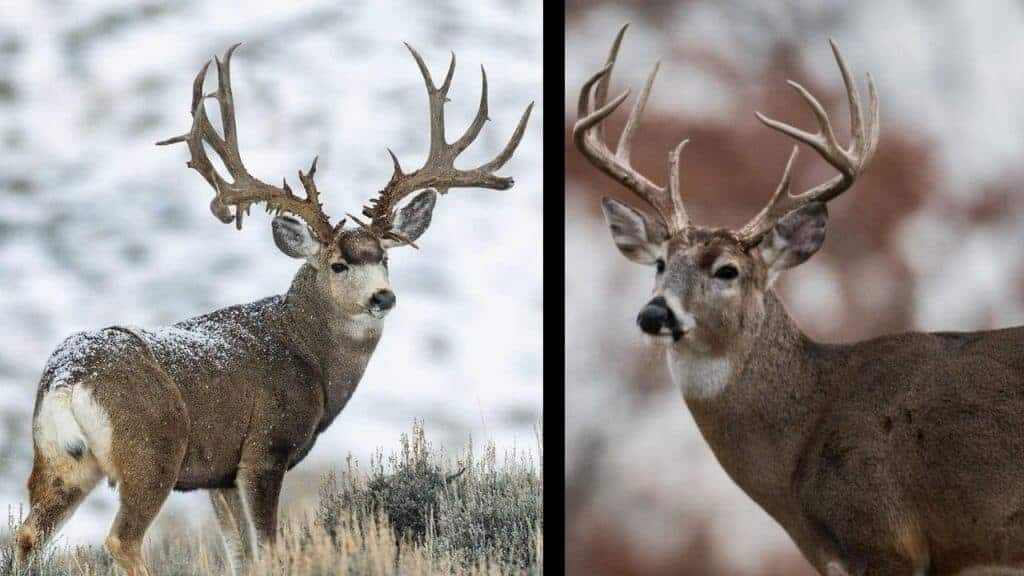
The Rear
If you have the angle, the rear of the deer can also give you an insight as to which species it is. Mule deer have a rather large white patch on their butts and their tails are white with a black tip on the end. Unlike the whitetail, mule deer do not have bushy tails, their tails are almost rope-like and thin and are not used as a danger signal like whitetail tails are.
Whitetail deer have a brown rear end with white coming up from their bellies and legs. The tops of their bushy tails are also brown until they raise them up. Underneath they are bright white and the white-tailed deer uses that bright white tail to signal to other deer that there is danger in the area as they run away. Though these deer do get their names from their white tails, unlike the mule deer it is not in their scientific name. Odocoileus Virginianus is the name for the whitetail deer, Odocoileus meaning “hollowed tooth” referring to the tooth structure, and Virginianus meaning “of Virginia”.

Overall Body Size
Body size alone is not a factor we can use to separate mule deer and whitetail deer. They are generally the same size. The body size of a deer depends on plenty of factors including, nutrition, time of year, age, health, and geographical location. Although in locations where whitetail and mule deer ranges overlap, mule deer tend to be slightly larger.
Deer in general follow Bergmann’s rule, which states that animals farther away from the equator will grow bigger than those close to it. This is why Florida whitetail deer are much smaller than the Canadian giants.
Geographic Territory
Mule deer and whitetail do not share the same core ranges, though they do overlap. Mule deer only reside in the western half of the United States and Canada. Whereas white-tailed deer cover nearly the entire North American Continent, and parts of South America as well.
Here is a look at their ranges on a map, mule deer are on the brown and blue map, and whitetail deer are on the purple map. These maps are from deerfamily.com and mt.gov.
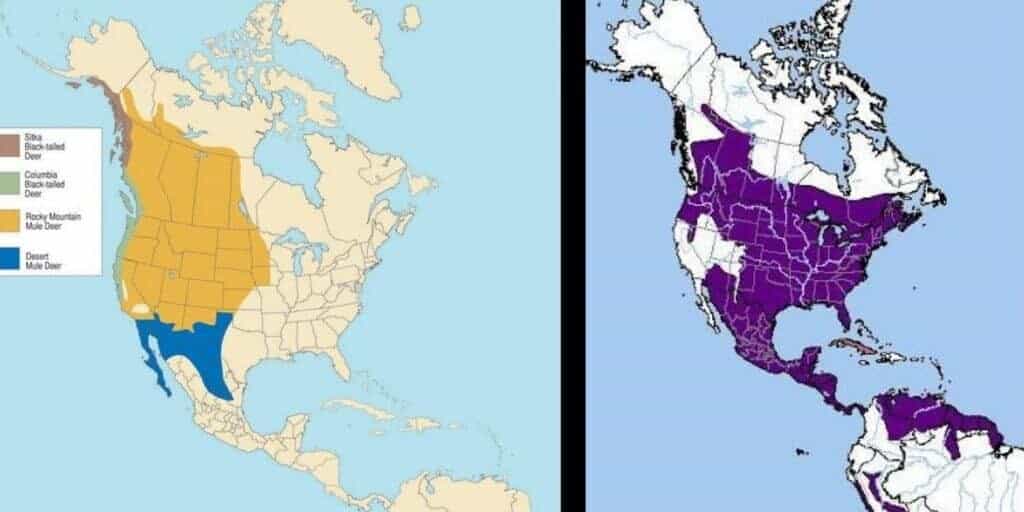
General Behavior
To start off, mule deer have much larger home ranges than whitetail do. A whitetail deer can easily spend its life inside a square mile. Although bucks may travel outside this distance during the rut. Whereas mule deer travel around hundreds of miles throughout the year. The reason for this is their diets and the climates they live in.
Whitetail live in the lowlands, which have plenty of food and manageable winters. So they do not have to move very much to find food no matter what time of year it is. Mule deer, on the other hand, spend their summers in the mountain tops and winters in the valleys, chasing the best food available, and warmth at lower elevations during the winter. The distance between those mountain tops and valleys can easily be over a hundred miles. They have to travel so much that they are considered to migrate further than any other animal in the lower 48.
Attitude
Whitetail are typically fairly skittish animals. They are constantly looking and smelling for danger. If there was a sudden noise or flash of movement, whitetail are sure to throw up their tail and run a few yards away. If they decide that something is a real threat they will quickly throw up their tail and dart through the woods until they are nowhere near the danger. Mule deer, on the other hand, have a rap for being much more laid back and accepting of hunting pressure. They do not spook as easily. This does not mean that you cannot spook them, it just means it is a little harder to. Although if they do sense danger, they will do their signature “hop” away called sotting which mule deer are known for. Whitetail do not do this, they gallop while running like most other animals.
Diet
Mule deer and whitetail, more or less, eat the same things. They are grazers that feed off of hundreds of different plants. Most of those plants are forbs, shrubs, saplings, and man-made food plots. Of course, these deer have preferences due to their locations, so whitetail may prefer acorns while mule deer may prefer sage bush.
The Rut
The two species have slightly different reproductive processes. For starters, whitetail deer have their rut from November to about early December, and Mule deer have their rut only during the month of November. The mule deer rut also occurs during their migration. Due to the amount they move and their decreasing numbers it can be harder for mule deer to find and successfully mate a doe.
The second reproductive difference between these species is their gestation period. Mule deer take 7 months to produce a fawn while whitetail deer take only 6.5 months. It is just a two-week difference but this actually leads to higher birth rates for the overall population of whitetails.
Lastly, whitetail does need to be 6 to 8 months old in order to breed, but mule deer does have to be 18 months old to reach sexual maturity. You can see how this would also help whitetail out-breed mule deer. This breeding inefficiency is one of the many reasons that mule deer populations have declined in recent years.
How They Are Hunted
We have already talked about how whitetail and mule deer have very different attitudes. Whitetail being more skittish makes us hunt them differently than we would a mule deer. For whitetail, the most popular way to hunt them is some sort of ambush. We can do this by climbing up in a tree stand or sitting in a ground blind. Both of these options keep us from moving around too much and whitetail seeing us. So we sit and wait for a whitetail to present a shooting opportunity while staying undetected. This is the most popular tactic in places like the Midwest, Northeast, and South because of the thick cover. Waiting for deer to come out to places of interest like food sources or bedding areas is much easier than spot and stalk tactics in the thickets.
As for mule deer, these same strategies may be harder to use due to the terrain they live in. A popular form of mule deer hunting is spot and stalk. This is when you spot a mule deer from one place (probably far away) and sneak around to somewhere that presents a shot on said mule deer. Easier said than done.
Whitetailed Mulies | Hybrids
Whitetail and mule deer are very similar and from time to time they do interbreed. Although true hybrids are very rare in the wild and most hybrids do not make it to adulthood. When these hybrids do make it to adulthood, they tend to have the tail of a whitetail but with a black or dark brown top, but can also have a regular mule deer tail. Their antlers tend to look more like whitetail antlers. Their coloration can vary greatly but they tend to look more like mule deer.

Male hybrids are always sterile, although females tend to be fertile and can mate with their parent species. This small fact alone keeps this hybrid from becoming its own species. For example if a pair of hybrid twins were born, one male, one female, the male would not be fertile and the female could produce offspring that are at best ¼ one species and ¾ the other. Percentages would dwindle from there.
Another semi-funny thing about whitetail and mule deer hybrids is that they seem to inherit both parent’s instincts for predator avoidance. Which in this case are dramatically different. Whitetail focus on speed and darting away as fast as possible to put distance between them and the threat, whereas mule deer use sotting to get away. Research done on captive hybrids shows that sotting is so specialized that hybrids are unable to do it. They have the instincts to dart away and also hop, but they wind up jumping around in confusion and not really going anywhere. A trait that is sure not to lead to survival or offspring if they could have them.
Evolution & History
Whitetail deer are just about the oldest deer that there are. For around 4 million years they have existed nearly unchanged. Mule deer, on the other hand, have only existed for around 10,000 years. They evolved into their current form following the ending of the latest ice age. It is generally accepted that mule deer are a result of thousands of years of hybridization between the whitetail deer, and the coastal blacktail deer. Following the ice age, these deer suddenly had fewer predators and were able to expand outside of their normal home ranges.
Ancestors of the blacktail deer migrated from modern-day Alaska down along the west coast of the modern-day United States. Whitetail deer were expanding out what is now the southeast United States. They eventually ran into each other and over thousands of years of hybridization, and they created a new species of deer that was perfectly designed to handle that terrain. So the mule deer soon took over and dominated the area. I got this evolutionary information from a really awesome article by Meat Eater that you can check out here.
Conclusion
While we can see how whitetail and mule deer are very similar, they are also quite different. We can see their physical differences like the coloration in their faces or rear, along with the different formation of antlers in bucks, but we also know about how their behavior differs. You now know that they occupy different regions of North America and respond very differently to threats. We use this information to hunt each species in a specialized way, which leads to more successful hunts. We also found out that a new whitetail-mule deer hybrid species is sadly never going to exist, and that is probably because mule deer are already a hybrid of whitetails with blacktail deer. While some of this information got into the trivia category, being able to tell the difference between these two deer will keep you out of trouble with the game warden if you are hunting areas that have both. Plus, learning everything you can about the topic is the only way to become a better hunter.
Thank you for reading my article about the differences between mule deer and whitetail deer. I hope you enjoyed it and learned something you didn’t already know. If you like my content, subscribe to my weekly update. If you have any other questions about the differences in mule deer and whitetail deer or just want to connect, feel free to email me at Patrick.Long@omegaoutdoors.net.
